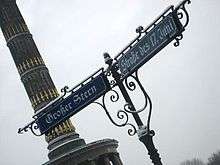Straße des 17. Juni

The Straße des 17. Juni (German pronunciation: [ˈʃtʁaːsə dɛs ˈziːpˌtseːntən ˈjuːniː], English: 17th of June Street) is a street in central Berlin, the capital of Germany. It is the western continuation of the boulevard Unter den Linden. It runs east-west through the Tiergarten, a large park to the west of the city centre. At the eastern end of the street is the Brandenburg Gate, it then passes the Soviet War Memorial before passing either side of Victory Column (Siegessäule) in the middle of the park, and out of the park through the Charlottenburg Gate, terminating about half a kilometre later at Ernst-Reuter-Platz. The street is a section of the main western thoroughfare radiating out from the centre of Berlin so the road continues to the west of Ernst-Reuter-Platz the first section of which is called Bismarkstrasse.
Before 1953, the street was called Charlottenburger Chaussee, because it ran from the old city center (Berlin-Mitte) to the borough of Charlottenburg through the Tiergarten ("Animal garden or Zoo").
It was made into a paved road in 1799, and owing to Berlin's rapid growth in the 19th century it became a major thoroughfare to the affluent western suburbs. At the outbreak of World War One in early August 1914, hundreds of thousands of Berliners cheered the military parade, which took place here.[1] At the outbreak of World War Two, no such scenes were seen, according to the American journalist and historian William L. Shirer,[2] but after Adolf Hitler returned from his inspection of Paris in 1940, a huge victory parade was held.
Charlottenburger Chausee was a part of the Ost-West-Achse (East-West Axis), which during the Nazi period became a triumphal avenue lined with Nazi flags. During the Nazi era, the boulevard was made broader and the old Prussian Victory Column was moved from in front of the Reichstag to the roundabout in the middle of the Tiergarten, where it has remained since 1938.
The Charlottenburger Chaussee was to have formed one aspect of the remodelling of the city of Berlin into the renamed city called Germania, designed by Hitler, Albert Speer, Professor Troost etc to be the capital of the Reich.[3]
In the last weeks of World War II, when Berlin's airports were unusable, it was used as a landing strip.[4]
In 1953, West Berlin renamed the street Straße des 17. Juni, to commemorate the uprising of the East Berliner workers on 17 June 1953, when the Red Army and GDR Volkspolizei shot protesting workers.
The street has in recent years been used for mega-events such as Love parade or live8. In 2006, the street was closed for six weeks to use it as Fanmeile (fan mile) during the 2006 Football World Cup. It also serves as the starting point for the Berlin Marathon. Every New Year's Eve, the street is also one of the gathering points in Berlin where usually over a million people gather to watch a stage show at the Brandenburg Gate, party and see fireworks go off at midnight. It is the largest such party in Europe, if not the world.[5]
References
- ↑ H.P. Wilmott World War One
- ↑ William L. Shirer, The Rise and Fall of the Third Reich
- ↑ Connolly, Kate (2016-04-14). "Story of cities #22: how Hitler's plans for Germania would have torn Berlin apart". the Guardian. Retrieved 2016-05-10.
- ↑ Beevor, Antony (2002). Berlin: The Downfall 1945. London; New York: Viking-Penguin Books. p. 322. ISBN 0-670-03041-4.
- ↑ "Berlin feiert am Brandenburger Tor ins neue Jahr 2013 (in German)". Berliner Morgenpost. 2007-03-04.
External links
| Wikimedia Commons has media related to Straße des 17. Juni. |
Coordinates: 52°30′51″N 13°21′02″E / 52.51417°N 13.35056°E